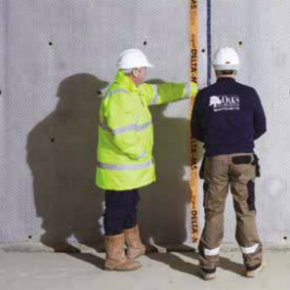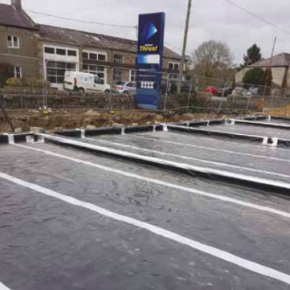
Delta Membranes encourages good practice in structural waterproofing and ground gas protection
Kevin Dodds, Director at Delta Membrane System Limited, explores the complexities and challenges on structural waterproofing projects which also require ground gas protection.
 Waterproofing structures offer protection to structural components, buildings, and installations from the penetration of water; they reduce risk and prolong the lifetime of the structure. However, some below ground construction projects require protection from both water ingress and gas contamination.
Waterproofing structures offer protection to structural components, buildings, and installations from the penetration of water; they reduce risk and prolong the lifetime of the structure. However, some below ground construction projects require protection from both water ingress and gas contamination.
It’s now possible to produce a waterproofing design which incorporates both a waterproof and gas proof protection system, however, these types of projects require a unique strategy and methodology. Both BS8102:2009 and BS8485:20015 are intertwined. Basements and below ground structures which need to be watertight and gas proof require further considerations at the design phase and throughout the project.
The consequences of ground gas contamination can be serious, as demonstrated by Gorebridge, which recently hit the headlines when 22 residents of 64 newly built homes suffered the effects.
Midlothian council developed a former mining area for 64 new homes in Gorebridge, taking all appropriate measures to ensure there would be no ground gas contamination in these homes. However, it was later discovered that no gas proof membrane was incorporated in the floor slab construction….the reason – it wasn’t specified.
The Gorebridge incident could be an exceptional event or ground gas contamination may be a more widespread issue yet to be
detected. But the incident demonstrates the importance of ground gas protection.
Innovations within the waterproofing sector have seen the introduction of Ground Gas Protection Systems, which are capable of
offering both gas protection and waterproof solution. A Waterproofing Design Specialist will be able to interpret the requirements of BS8102:2009 and BS8485:2015 to produce a waterproofing design which incorporates both a waterproof and gas proof protection system.
If a site has been identified with a gas or hydrocarbon contamination it will have been given a Characteristic Situation Score. The Characteristic Situation Score is defined according to how severe the gas flow from the ground is. All sites which have been characterised with a gas situation score will require a gas protection system, and where identified, a waterproof protection barrier.
Methods of gas protection
The control of gas penetration into properties is normally achieved by blocking the pathway or removing the source of the gas generation. Gas protection measures available to achieve the minimum points score requires a combination of two or more of the following protection measures be used:
• The Structural Barrier
• Ventilation Measures
• Gas Resistant Membrane
Methods of structural waterproofing
There are 3 Types of waterproofing methods:
• Type A Tanked or Barrier Protection. Cementitious or bitumen-based products applied internally, externally or sandwiched within the structure.
• Type B Structurally Integral Protection. Reinforced or prestressed concrete designed through composite and integrated details
such as water bars to be water resistant.
• Type C Drained Protection. Cavity Drainage Systems which allow for water ingress but in a controlled fashion.
Evaluation of groundwater conditions, risk assessment and options for drainage outside the structure should always be considered.
The dangers of ground gases
Hydrocarbons derive from the petrol chemistry industry and are highly toxic. Most Hydrocarbons have the potential to cause cancer.
Methane is formed where there is below ground degradation of organic substances e.g. landfill sites, sewage treatment areas, mining operations and peat bogs. It is an odourless flammable gas that is explosive when released into the atmosphere at levels as low as 5% and exposed to a source of ignition. Methane can migrate through subsoil and through cracks and fissures into buildings and structures. A build-up of methane to hazardous levels will cause harm to health and compromise safety.
Carbon Dioxide is an odourless and colourless toxic gas. In high concentrations can result in asphyxiation. The gas is formed by the oxidation of carbon compounds such as that which occurs in landfill sites. When Carbon Dioxide levels reach a concentration of 3%, symptoms of headaches and shortness of breath will occur, becoming severe at 5% between 7-10% will cause suffocation.
Radon occurs naturally in the environment, this radioactive gas is, colourless, odourless and tasteless. Radon can migrate into any building that is built over a source. If it accumulates in a building, it increases the risk of lung cancer for occupants. Radon is the cause of 15% of lung cancers worldwide (World Health Organisation ‘WHO’ 2009).
Volatile Organic Compounds (VOCs) are organic compounds that easily volatise under normal atmospheric conditions/environments to become vapours or gases. Along with carbon, they contain elements such as hydrogen, oxygen, fluorine, chlorine, bromine, sulphur or nitrogen. Typical VOCs encountered on brownfield and industrial sites include: Petroleum, benzene, toluene, butylbenzenes, chlorinated ethenes, Nitrogen, sulphur and tetrahydrofuran. VOCs in the air react with oxides of nitrogen in the presence of sunlight to form ozone.
Structural warranty provider requirements
Structural Warranty Providers such as NHBC stipulate that it is a mandatory requirement that a CSSW qualified Waterproofing
Designer is involved in the waterproofing design process and other warranty providers such as Premier Guarantees and LABC are following suit.
If you’re wondering how to find a waterproofing design specialist, the Property Care Association has devised a Register which provides a central point for individuals with the relevant waterproofing design skills. The PCA register allows developers, architects, builders etc to quickly locate vetted and approved Waterproofing Design Specialists who can assist in the design and planning of underground waterproofing.
A Waterproofing Design Specialist will work with architects, surveyors, contractors and engineers alike to provide a design
service which complies with BS8102:2009 and BS8485:2015 and offers detail to design. The ability to easily identify and engage a Waterproofing Design Specialist will allow a design team to conform to the recommendation set out in BS8102:2009 and BS8485:2015.
Delta Membrane Systems,
Delta House,
Merlin Way,
North Weald,
Epping,
Essex,
CM16 6HR
United Kingdom
Visit Delta Membrane Systems' website
Visit Supplier's page
Latest news

28th March 2025
Ideal Heating Commercial announces 10-year warranty on Evomax 2 boiler
Evomax 2, the UK’s number one selling commercial wall-mounted boiler from Ideal Heating Commercial, is now available with a 10-year warranty.
Posted in Articles, Building Industry News, Building Products & Structures, Building Regulations & Accreditations, Building Services, Facility Management & Building Services, Heating Systems, Controls and Management, Heating, Ventilation and Air Conditioning - HVAC, Innovations & New Products, Pipes, Pipes & Fittings, Plumbing, Retrofit & Renovation, Sustainability & Energy Efficiency, Videos
28th March 2025
FLIR Si1-LD Acoustic Imaging Camera for Compressed Air Leak Detection
FLIR, a Teledyne Technologies company, introduces the Si1-LD, an industrial acoustic imaging camera that brings faster and more accurate compressed air leak detection to those operating on a modest condition monitoring budget.
Posted in Acoustics, Noise & Vibration Control, Articles, Building Industry News, Building Products & Structures, Building Services, Facility Management & Building Services, Information Technology, Innovations & New Products, Retrofit & Renovation, Sustainability & Energy Efficiency, Thermal Imaging and Monitors
28th March 2025
LIFTEX 2025 Seminar programme announced
Registration has opened for LIFTEX 2025. Now in its 37th year, LIFTEX 2025 is the UK’s only dedicated exhibition for the lift, escalator and access industry and takes place only once every three years.
Posted in Access Control & Door Entry Systems, Accessibility, Articles, Building Industry Events, Building Industry News, Building Products & Structures, Building Regulations & Accreditations, Building Services, Exhibitions and Conferences, Facility Management & Building Services, Health & Safety, Retrofit & Renovation, Security and Fire Protection, Seminars
28th March 2025
MCRMA welcomes ArcelorMittal UK to membership
A UK division of the global steelmaking business ArcelorMittal has become the latest new member of the MCRMA, the industry association representing the metal building envelope sector.
Posted in Articles, Building Associations & Institutes, Building Industry News, Building Products & Structures, Building Systems, Cladding, Facades, Posts, Restoration & Refurbishment, Retrofit & Renovation, Roofs, Steel and Structural Frames, Walls
 Sign up:
Sign up: